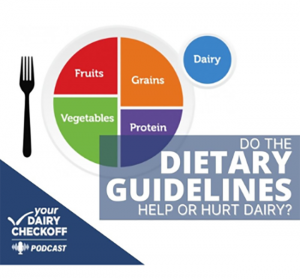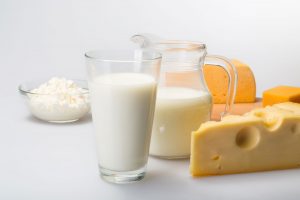The Your Dairy Checkoff Podcast was designed to address questions and topics farmers most often have about the work the dairy checkoff does with their investment.
We’ve tackled many subjects, ranging from advertising to working with foodservice leaders to exports. Recently, we addressed another subject of interest: Do the Dietary Guidelines Help or Hurt Dairy? You May Be Surprised.

Dairy farmer hosts Audrey Donahoe of New York, who serves as chair of National Dairy Council, and Jennifer Glover from Georgia, were joined by their farming peer, Abbey Copenhaver, also from New York. In addition to farming, Copenhaver works as a registered dietitian, specializing in agriculture food systems and sustainability, including on-farm practices, food processing, preparation, and cooking.
The podcast conversation was rounded out by Dr. Katie Brown, senior vice president of scientific and nutrition affairs at National Dairy Council.
Brown offered some background on the Dietary Guidelines for Americans (DGA), which are designed to promote health and prevent disease, or what she calls “the nation’s eating advice, and it’s based on science.”
The DGA are produced and updated every five years by the U.S. Department of Agriculture and the Department of Health and Human Services. Brown said the DGA align with National Dairy Council’s longtime commitment to public health, and she shared insights on the role the checkoff can — and cannot — play during the updating process, which occurs next in 2025.
“National Dairy Council cannot influence but we can inform the Dietary Guidelines process because NDC is a checkoff program,” Brown said. “We operate under the Dairy Production Stabilization Act and are not allowed to lobby. We can’t influence the government to make changes to its nutrition policy, but as a leader in science-based dairy nutrition information, National Dairy Council is permitted to participate in the request for comments to share factual information with the committee (through the public comment process).”

The benefit of full-fat dairy is among the research NDC has presented to the committee, and Brown said saturated fat will be one area of focus for the 2025 update.
“It gives us an opportunity to amplify science about the wellness benefits of dairy foods like milk, cheese and yogurt at all fat levels,” Brown said. “So that’s going to be an important opportunity for us and we’re continuing to invest in science on dairy foods at all fat levels that will contribute to the growing evidence on this topic.
“We’re seeing whole milk as the greatest growth area of any milk fat level and it’s a great reinforcement that the tide is turning in this area.”
Brown added that the DGA is foundational to federal nutrition security programs, including school meals, Special Supplemental Nutrition Program for Women, Infants, and Children (WIC) and to the Supplemental Nutrition Assistance Program (SNAP). These programs receive $114 billion annually, supporting access to nutritious food and meals, including dairy, that reach 80 million children and adults. Brown said this equates to about 12 billion pounds of dairy, which is supplied by U.S. dairy farmers.
“All of us who work for dairy farmers are proud of dairy’s wellness, legacy and our reputation,” Brown said. “I think it’s important for the dairy farmers to know their checkoff investment in research to discover the nutritional and wellness benefits of dairy has added such significant value to public health in our country and around the world. And because of that evidence, dairy has been included in every edition of the U.S. Dietary Guidelines for the past 40 years.”
To listen to the entire conversation, click here.


